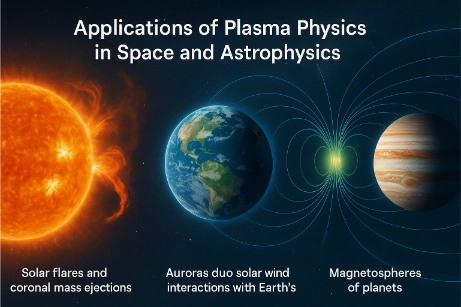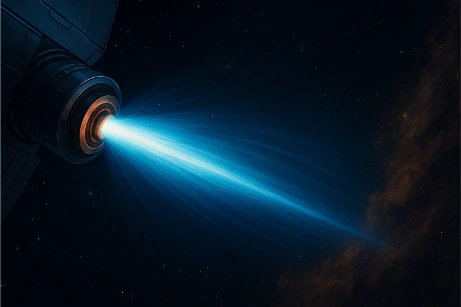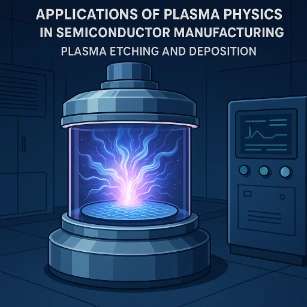Plasma Physics
Plasma physics explores the properties and behaviors of the fourth state of matter—plasma—which occurs when gases are energized to the point that electrons are stripped from atoms, creating a mix of ions and free electrons. This field sits at the intersection of physics and electricity & magnetism, as plasma is deeply influenced by electric and magnetic forces. Plasmas dominate the visible universe, forming stars, lightning, auroras, and are used in technologies like fluorescent lights and fusion research.
Understanding the fundamentals of electrical circuits and electrodynamics lays the groundwork for comprehending how electric currents and electromagnetic forces behave in plasma systems. Phenomena such as electromagnetic induction and electromagnetic waves gain new complexity when considered in the ionized environment of plasma, where interactions are governed by collective motion rather than isolated particle behavior.
An understanding of electrostatics and magnetic fields becomes essential in studying how plasmas are confined or manipulated in devices such as tokamaks or stellarators. These principles also apply in natural settings like the solar corona or planetary magnetospheres. Plasma often exists in dynamic systems, requiring insights from magnetohydrodynamics (MHD), which couples fluid dynamics with magnetic effects.
Meanwhile, the relative simplicity of magnetostatics offers a contrast to the often turbulent and high-energy behavior observed in plasma. Advanced topics like quantum electrodynamics (QED) allow students to explore plasma interactions at quantum levels, particularly in high-energy astrophysics or laser-induced plasma studies.
The practical and theoretical insights from superconductivity are also relevant when dealing with magnetic confinement and current flow in plasma systems. Similarly, the broad study of light and optics intersects with plasma physics in many areas, such as how electromagnetic radiation propagates through or is emitted by plasmas.
Techniques involving laser optics are often employed to create or probe plasmas in laboratory settings, while fiber optic systems can help detect or monitor emissions. The study of atmospheric and environmental optics also considers plasma effects in the upper atmosphere, such as ionospheric disturbances or auroral displays.
Research in bio-optics occasionally overlaps with plasma applications, such as in sterilization or plasma-based medical treatments. Concepts from geometrical optics and nonlinear optics are necessary to model the behavior of intense laser pulses interacting with plasma.
Technologies like photonics and visual optics contribute to diagnostics and imaging techniques used to investigate plasma parameters. Fundamental interference and diffraction principles from wave optics help in studying wave-plasma interactions.
Finally, quantum optics and modern physics provide the theoretical backbone to understand how plasma behaviors emerge from quantum and relativistic interactions in high-energy environments, such as particle accelerators or solar flares. Together, these interconnected topics reveal that plasma physics is not only a fundamental science but also a bridge to emerging technologies and cosmic phenomena.

Characteristics of Plasma
1. Ionization
Plasmas are formed when a gas is energized to the point that electrons are stripped from atoms, creating a mixture of free electrons and positively charged ions. This process is called ionization.
- Fully ionized plasma: Most atoms are ionized (e.g., the core of stars).
- Partially ionized plasma: Some neutral atoms remain (e.g., Earth’s ionosphere).
2. Quasineutrality
Plasma is quasineutral, meaning the densities of positive and negative charges are nearly equal, maintaining an overall charge balance:
3. Collective Behavior
Plasma particles interact through long-range electromagnetic forces, causing collective behavior where particles respond to the averaged fields rather than individual interactions.
4. Debye Shielding
Charged particles in plasma rearrange themselves to shield out electric potentials over a characteristic distance called the Debye length
Debye length
= Square Root of [{(Permittivity of Free Space)(Boltzmann Constant)(Electron Temperature)}/{(electron density)(Square of elementary charge)}]
Types of Plasma
1. Natural Plasma
- Astrophysical Plasma: Found in stars, interstellar medium, and solar winds.
- Ionospheric Plasma: Exists in Earth’s upper atmosphere, affecting radio communications.
- Auroras and Lightning: Examples of atmospheric plasma on Earth.
2. Laboratory Plasma
- Thermal Plasma: Electrons and ions are in thermal equilibrium (e.g., fusion reactors).
- Non-Thermal Plasma: Electrons are much hotter than ions (e.g., fluorescent lamps).
3. High-Temperature Plasma
Produced in devices like tokamaks and stellarators for nuclear fusion, reaching millions of degrees Celsius.
4. Low-Temperature Plasma
Used in industrial applications, such as plasma etching and surface treatment.
Fundamental Plasma Parameters
1. Plasma Frequency (
)
The natural frequency of electron oscillations in plasma:
Where
is the electron mass.
2. Cyclotron Frequency (
)
The frequency at which charged particles spiral around magnetic field lines:
Where
is the magnetic field strength.
3. Magnetization
A plasma is said to be magnetized if the Larmor radius (radius of particle spiraling) is much smaller than the system size.
4. Plasma Beta (
)
The ratio of plasma pressure to magnetic pressure:
- High-beta plasmas: Pressure-dominated (fusion reactors).
- Low-beta plasmas: Magnetically dominated (solar corona).
Basic Plasma Equations
1. Fluid Description of Plasma
Plasma behavior can be described using fluid equations, derived from Navier-Stokes and Maxwell’s equations.
Continuity Equation (Conservation of Mass):
Momentum Equation (Force Balance):
Energy Equation: Governs energy transport in the plasma.
2. Kinetic Description
Involves the Vlasov equation, which describes how the distribution function
of particles evolves over time.
Plasma Waves and Instabilities
1. Plasma Oscillations
Electrons oscillate collectively against a stationary background of ions at the plasma frequency.
2. Alfven Waves
Low-frequency oscillations that propagate along magnetic field lines, significant in space plasmas.
3. Magnetohydrodynamic (MHD) Waves
Waves in magnetized plasma that combine fluid motion with electromagnetic fields.
4. Plasma Instabilities
Disturbances that grow over time, leading to turbulence or disruptions in plasma.
- Rayleigh-Taylor Instability: Occurs when a heavier fluid pushes against a lighter one in a gravitational field.
- Kink Instability: Affects magnetically confined plasma in fusion reactors.
Applications of Plasma Physics
1. Controlled Nuclear Fusion
Devices like tokamaks and stellarators aim to harness the energy of fusion by confining plasma at extremely high temperatures and pressures.

2. Space and Astrophysics
Plasma physics explains:
- Solar flares and coronal mass ejections (CMEs).
- Auroras due to solar wind interactions with Earth’s magnetosphere.
- Magnetospheres of planets.

3. Plasma Propulsion
Ion thrusters and Hall-effect thrusters use plasma to propel spacecraft, offering high efficiency for deep-space missions.

4. Industrial Applications
- Semiconductor manufacturing: Plasma etching and deposition.

- Plasma cutting: For precision metal cutting.

- Surface modification: Enhancing materials’ durability and conductivity.

5. Medical Applications
- Plasma sterilization: Killing bacteria without heat.
- Plasma medicine: Accelerating wound healing and cancer treatment.

Five Numerical Examples
Example 1: Plasma Frequency
Problem:
Find the plasma frequency for an electron density of
.
Solution:
Example 2: Debye Length
Problem:
Calculate the Debye length for a plasma with
and
.
Solution:
Why Study Plasma Physics
Understanding the Fourth State of Matter
Plasma, often referred to as the fourth state of matter, consists of ionized gases where charged particles interact with electric and magnetic fields. Students study how these particles behave collectively, leading to phenomena such as Debye shielding, plasma oscillations, and magnetic confinement. This subject opens the door to a deeper understanding of systems that are neither solid, liquid, nor gas, but exhibit characteristics of all three under specific conditions. Plasma physics expands students’ perspectives beyond traditional matter behavior encountered in earlier physics courses.
Applications in Astrophysics and Fusion Energy
Plasmas make up over 99% of the visible universe, including stars, solar winds, and nebulae. Students explore how plasma physics is crucial in understanding space weather, star formation, and cosmic radiation. On Earth, plasma confinement is the central challenge in developing controlled nuclear fusion, a potential source of nearly limitless clean energy. Knowledge in this area connects fundamental physics with practical solutions for the future of global energy sustainability.
Wave Propagation and Instabilities
Students investigate the propagation of electromagnetic and electrostatic waves in plasma, including Alfvén waves, Langmuir waves, and ion-acoustic modes. They also study the mechanisms behind plasma instabilities and turbulence, which are key challenges in fusion reactor design. These complex dynamics are analyzed using both analytical and numerical methods. Mastery of wave behavior in plasmas is vital for predicting and controlling plasma systems in both laboratory and astrophysical settings.
Mathematical Modeling and Simulation
Plasma physics involves solving partial differential equations such as the Vlasov, Boltzmann, and MHD equations. Students develop strong mathematical and computational skills, using tools like particle-in-cell (PIC) simulations and fluid models. This computational expertise prepares them for research and applications that require high-performance computing. It also cultivates a deeper appreciation for the challenges of modeling complex, nonlinear systems.
Interdisciplinary Opportunities and Research Potential
Plasma physics intersects with electromagnetism, thermodynamics, quantum mechanics, and fluid dynamics. Students pursuing this field can engage in research areas such as space exploration, nuclear fusion, and advanced materials. It offers opportunities for both theoretical investigation and experimental design. Studying plasma physics equips students to tackle some of the most exciting and impactful problems in modern science and engineering.
Conclusion
Plasma physics is a rich and expansive field that explains the behavior of the most abundant state of matter in the universe. From the fusion energy that powers the stars to cutting-edge technologies like plasma propulsion and semiconductor manufacturing, the study of plasmas continues to unlock the potential for scientific and technological breakthroughs.
Review Questions and Answers:
1. What is plasma and how does it differ from the other states of matter?
Answer: Plasma is an ionized gas consisting of free electrons and ions, making it electrically conductive and highly responsive to electromagnetic fields. Unlike solids, liquids, or gases, plasma exhibits collective behavior and unique properties such as Debye shielding.
2. How is the ionization of a gas achieved to form plasma?
Answer: Ionization occurs when sufficient energy (thermal, electrical, or radiative) is supplied to a gas, freeing electrons from atoms or molecules. This process creates a mix of charged particles that defines the plasma state.
3. What is the Debye length in plasma physics, and why is it significant?
Answer: The Debye length is the scale over which electric fields are screened out in a plasma due to the redistribution of charges. It determines the distance over which charge imbalances can persist and is crucial for defining the quasi-neutrality of plasma.
4. What is plasma frequency, and what does it indicate about a plasma?
Answer: Plasma frequency is the natural oscillation frequency of electrons in a plasma when disturbed from equilibrium. It indicates how fast the plasma can respond to electric field changes and plays a key role in wave propagation and shielding.
5. How do electromagnetic fields influence the behavior of plasmas?
Answer: In plasma, electromagnetic fields exert forces on the charged particles, driving complex motions such as gyration, drift, and wave propagation. These interactions are described by magnetohydrodynamics and are central to many plasma applications.
6. What role does temperature play in determining plasma properties?
Answer: Temperature in plasma governs the kinetic energy of particles, affecting ionization levels, collision rates, and conductivity. High temperatures generally lead to higher degrees of ionization and more dynamic behavior.
7. How is plasma used in controlled nuclear fusion experiments?
Answer: In fusion experiments, plasma is confined using magnetic fields (magnetic confinement) or inertial methods to achieve conditions necessary for fusion reactions. The aim is to produce energy by fusing light nuclei, such as deuterium and tritium, under extreme temperatures and pressures.
8. What are some common instabilities observed in plasmas, and why are they important?
Answer: Instabilities such as the Rayleigh–Taylor, Kelvin–Helmholtz, and kink instabilities can disrupt plasma confinement. Understanding and controlling these instabilities are critical for achieving stable plasma in fusion reactors and other applications.
9. How do laboratory plasmas differ from astrophysical plasmas?
Answer: Laboratory plasmas are typically created under controlled conditions and may have higher densities and lower temperatures compared to astrophysical plasmas, which exist naturally in vast, diffuse regions like the solar wind or interstellar medium and often exhibit complex magnetic field structures.
10. What measurement techniques are used to diagnose plasma properties in experiments?
Answer: Diagnostic techniques include Langmuir probes, interferometry, spectroscopy, and magnetic probes. These methods help determine parameters such as electron density, temperature, and magnetic field strength, which are vital for understanding plasma behavior.
Thought-Provoking Questions and Answers:
1. How does the concept of Debye shielding influence the behavior of plasmas in both laboratory and astrophysical settings?
Answer: Debye shielding prevents long-range electric fields from influencing plasma behavior by rapidly neutralizing charge imbalances. In laboratories, it ensures that plasmas remain quasi-neutral, while in astrophysical environments, it affects phenomena like star formation and the propagation of charged particles in space.
2. In what ways could breakthroughs in plasma confinement lead to practical fusion energy?
Answer: Improved plasma confinement, such as through advanced magnetic configurations or inertial confinement techniques, can reduce energy losses and sustain the high temperatures and pressures required for fusion. This would make fusion energy a viable, clean power source, transforming global energy production.
3. How might the study of plasma instabilities contribute to our understanding of space weather phenomena?
Answer: Plasma instabilities are key drivers of solar flares, coronal mass ejections, and other space weather events. By studying these instabilities, scientists can better predict space weather, protect satellites and power grids, and understand the fundamental processes occurring in the Sun’s atmosphere.
4. What potential do nanostructured materials have in manipulating plasma behavior for advanced applications?
Answer: Nanostructured materials can offer tailored electromagnetic properties and enhanced surface interactions, which may be used to control plasma boundaries, enhance confinement, or improve energy absorption. This could lead to more efficient fusion reactors, plasma-based sensors, and novel propulsion systems.
5. How do differences in plasma density and temperature affect the design of plasma diagnostic tools?
Answer: Diagnostic tools must be sensitive enough to measure the high-speed, low-density, or high-temperature conditions typical in different plasmas. Tailoring instruments like Langmuir probes or spectrometers to specific plasma parameters is crucial for accurate measurement and analysis.
6. How can advances in computational simulations deepen our understanding of magnetohydrodynamic (MHD) phenomena in plasmas?
Answer: High-fidelity simulations allow for the modeling of complex plasma behavior under varying conditions, capturing turbulence, instabilities, and non-linear interactions. These computational tools enable researchers to test theories, optimize fusion reactor designs, and predict plasma responses in space weather.
7. In what ways might plasma physics contribute to the development of next-generation propulsion systems for space exploration?
Answer: Plasma propulsion systems, such as ion thrusters and Hall-effect thrusters, leverage plasma properties to produce high-efficiency, low-thrust propulsion. Advances in plasma control and energy management could result in more efficient spacecraft propulsion, enabling longer missions and deeper space exploration.
8. How do electromagnetic waves interact with plasmas, and what implications does this have for communication technologies in space?
Answer: Electromagnetic waves can be absorbed, reflected, or refracted by plasmas, influencing signal propagation in space. Understanding these interactions is crucial for designing communication systems that can withstand space weather effects and maintain reliable contact with spacecraft.
9. How might the integration of plasma physics with renewable energy technologies impact the future of power generation?
Answer: Plasma processes can be used to enhance energy conversion in solar cells and to develop plasma-based chemical reactors for fuel production. Integrating plasma physics with renewable energy can lead to more efficient, sustainable, and versatile power generation methods.
10. What are the challenges and prospects of using plasmas for environmental applications, such as waste treatment or water purification?
Answer: Plasmas can generate reactive species that break down pollutants and sterilize water. Challenges include controlling plasma reactions, scaling up the technology, and ensuring energy efficiency. Advances in plasma technology could lead to effective, eco-friendly solutions for environmental remediation.
11. How does the interplay between magnetic fields and plasma turbulence affect the stability of fusion reactors?
Answer: Turbulence in plasma can lead to enhanced transport of energy and particles, undermining confinement in fusion reactors. Understanding and mitigating turbulence through magnetic field configuration and plasma control strategies is vital for achieving stable, sustained fusion reactions.
12. How might future interdisciplinary research in plasma physics and materials science lead to breakthroughs in energy storage and conversion?
Answer: Interdisciplinary research can develop new materials that withstand extreme plasma conditions while efficiently converting energy. Such breakthroughs could enhance the performance of plasma-based energy systems, lead to innovative energy storage solutions, and open up new avenues in both renewable energy and fusion power.
Numerical Problems and Solutions:
1. A plasma has an electron density of
1×1018 m
−3 and an electron temperature of 10 eV. Calculate the Debye length.
Solution:
Convert temperature:
Debye length,
.
Using
,
(but note we already converted T to Joules), and
.
A more direct formula (in SI) is:
Calculate denominator:
Then, numerator:
.
Thus,
.
.
2. Calculate the electron plasma frequency for a plasma with electron density
5×1018 m
−3.
Solution:
Plasma frequency,
.
Using
,
,
.
.
.
Numerator =
.
Denom =
.
3. A plasma has a magnetic field of 0.05 T. Calculate the electron cyclotron frequency.
Solution:
Cyclotron frequency,
.
4. In a fusion reactor, the plasma temperature is 15 keV. Convert this temperature to Kelvin.
Solution:
, so
.
Temperature
.
5. A magnetically confined plasma has an electron density of
m
. Calculate its Debye length if the electron temperature is 100 eV.
Solution:
.
.
Numerator =
.
Denom =
.
.
6. Calculate the energy (in joules) of a photon with a wavelength of 500 nm.
Solution:
Energy,
, where
and
.
.
7. A plasma in a laboratory experiment has an electron plasma frequency of
2×1011 rad/s. Estimate the electron density in the plasma.
Solution:
Squaring both sides:
.
.
.
Numerator =
.
Denom =
.
.
8. A magnetic field of 0.1 T is applied to a plasma. Calculate the electron cyclotron frequency.
Solution:
.
9. In a tokamak, the plasma current is 1 MA (1×10⁶ A) and flows through a cross-sectional area of 5 m². Estimate the current density in the plasma.
Solution:
Current density,
.
10. A plasma has an electron temperature of 50 eV. Convert this temperature to joules.
Solution:
.
.
11. A Langmuir probe in a plasma measures an electron saturation current of 2 mA. If the probe area is
m² and the electron temperature is 10 eV, estimate the electron density using a simplified formula
.
Solution:
Given
,
,
.
Convert
to Joules:
.
is not needed since we already have energy in joules, so assume
in joules is used directly.
.
Rearrange:
.
Compute
.
Now,
.
Denom =
.
Thus,
n.
12. In a plasma experiment, a coil with 50 turns and an area of 0.002 m² is used to measure a changing magnetic field. If the magnetic flux through the coil changes by 0.005 Wb in 0.1 s, calculate the induced EMF.
Solution:
Total change in flux for the coil: ΔΦ_total = 0.005 Wb.
Induced EMF,
.
